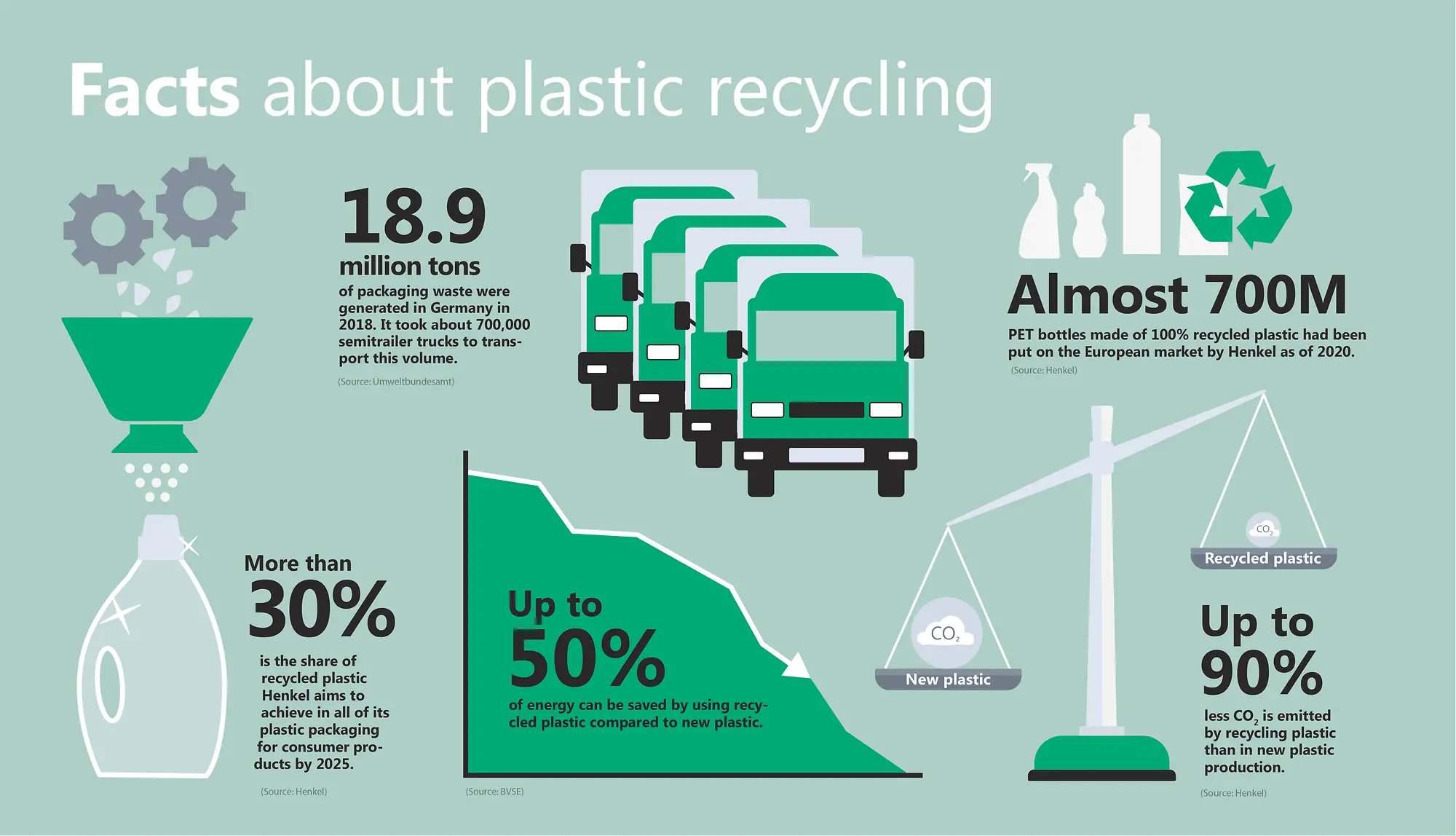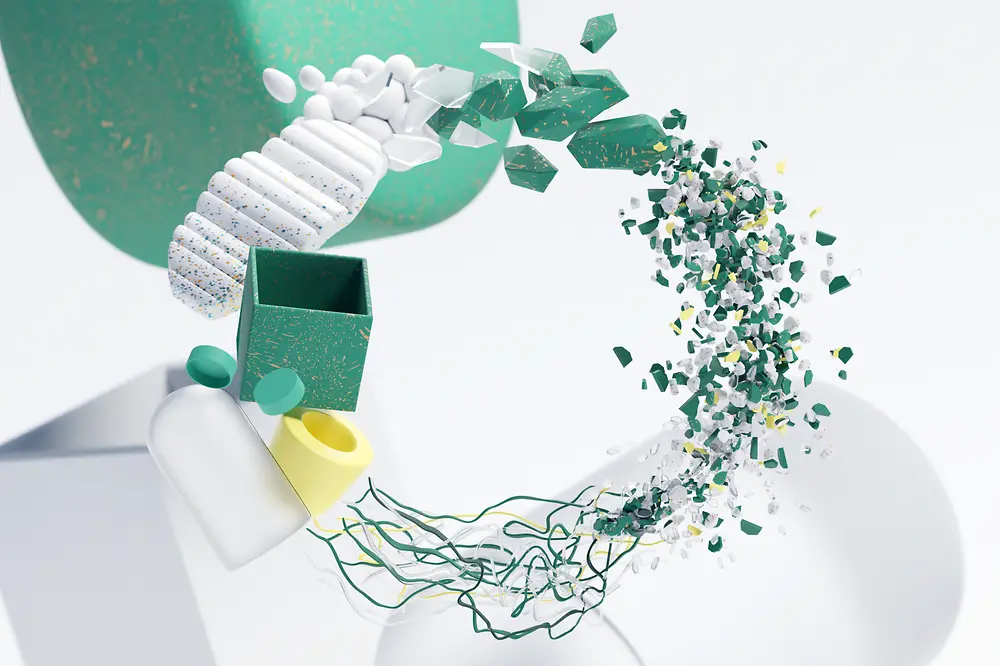Learn more about Henkel Brands & Businesses in UK & Irelands: Includes useful information about the brands, technologies and latest innovations in our business areas: Henkel Adhesive Technologies and Henkel Consumer Brands.
Recycling: Old plastic, new perspectives
From information and design all the way to protection and portability: plastic packaging fulfills a variety of functions that have become integral to the modern lifestyle. Plastic waste, however, constitutes a challenge for the environment and the global climate. Henkel has therefore committed to using plastic responsibly within a circular economy.

In this story, you'll learn:
- How plastics and climate protection are connected
- What is important about the circular economy as a guiding principle
- How we put 700 million bottles made from 100 percent recycled plastic on the market
- Why everyone has to take action when it comes to plastic recycling
- What role Thorsten Leopold, Director Global Packaging Innovation, Laundry & Home Care, sees for a functioning circular economy
In countries like Germany and Norway, the life cycle of a polyethylene terephthalate (PET) bottle begins and ends at the supermarket, where consumers return it after use. Unlike in many other countries, the bottle is not incinerated or spilled out into the ocean: it is collected by a reverse vending machine. Reusable bottles are simply cleaned and refilled. Single-use bottles are sorted by color, ground into PET flakes, washed and then melted back into recycled plastic, which can be used to manufacture new PET bottles and other types of product packaging. This kind of circular economy reduces overall resource consumption as materials are kept inside the economic production and consumption cycle for as long as possible.
Recycled plastic not only reduces the amount of plastic waste that is generated, it also has a significantly lower carbon footprint than new plastic made from fossil fuels. According to Dr. Christoph Hoffmann, Director Corporate Strategy, Sustainability & Circular Economy at packaging manufacturer ALPLA, many people are not aware of this fact. He gives a practical example: “The recycled plastic manufactured by one of our subsidiaries (the PET recycling team in Wöllersdorf, Germany) actually generates just one tenth of the greenhouse gas emissions that production of the ‘virgin’ material is responsible for.” When it comes to saving CO2 and reducing plastic waste, Henkel believes there is only one way forward: a circular economy must be created in which plastic is recycled and reused in a similar way to drink bottles at the supermarket.

Plastic is an actionable lever for the climate, too
Product and packaging design is an opportunity for consumer goods companies like Henkel to reduce carbon emissions and contribute to protecting the climate through the use of recycled plastic. The problem is that there is not enough high-quality recycled material available on the market. Systems do exist, like the yellow trash bag with which consumers can feed their used packaging back into a recycling loop, but empty packaging is often sorted incorrectly. In addition, not every country has such a recycling system in place, which means that many plastic containers end up in landfills. Two other factors also come into play: recycling plastic to a high standard of quality is a complex process and more expensive than making new material from fossil fuels. Not every plastic container can be recycled through this process, either – a problem that Henkel has set out to tackle.
To support a circular economy for so-called post-consumer waste, Henkel is working with several different partners. In collaboration with packaging manufacturers, we are focusing on closing the recycling circle with intelligent, recyclable packaging design and use of recycled plastic and bio-based materials. Rethinking packaging in this way reduces waste and its impact on the environment. Henkel has additionally partnered with various companies and initiatives that work on improving the recycling infrastructure to make a circular economy possible in the first place – for example by supporting recycling practices in developing countries.
The circular economy as a guiding principle
According to the Plastic Atlas 2019, published by German non-profit organizations Heinrich Böll Stiftung and BUND, more than 400 million tons of plastic are consumed around the world each year, a figure that is trending upwards. Not even a quarter of this plastic gets recycled. Manufacturing high-quality recycled plastic from jumbled packaging waste currently still represents a challenge compared to single-material collection of beverage bottles through a deposit system. When plastic is recycled, containers of all kinds are initially collected together, for example in the yellow trash bag, before being sorted by material type and reprocessed into plastic. The impurities and different colors present among the discarded materials pose a particular difficulty, with dark plastic being especially problematic because the recycled material cannot be used to manufacture light-colored packaging.
Alongside esthetic limitations like color, there are also quality limitations that can make processing the material more difficult or reduce its efficiency. Impurities such as foreign matter, for example, are detrimental to quality and lead to increased processing costs. Recycled materials therefore have to fulfill a set of key requirements pertaining to their safety, performance and quality – which, in turn, will require innovative solutions.
In collaboration with ALPLA, Henkel manufactured its first bottle made of chemically recycled plastic in 2019. This process makes it possible to recycle plastic blends that would otherwise have been left out into a high-quality material. The pilot project is part of the ChemCycling project launched by BASF and represents an important step towards sustainable packaging as it complements the mechanical processing of used plastic.

It is now well-known that recycling is an important lever for reducing waste. What many people are less attuned to is its contribution to climate protection.
Dr. Christoph Hoffmann, Director Corporate Strategy, Sustainability & Circular Economy at ALPLA
700 million bottles made of 100% recycled plastic
In 2020, Henkel reached an important milestone on its road towards sustainable packaging: we used more than 400 million bottles made entirely of recycled plastic for laundry detergents and cleaning agents like Pril or Vernel. In total, Henkel has already put 700 million bottles made of recycled plastic on the market.
The use of recycled materials allows energy savings of 33 to 50 percent from the new plastic that would otherwise have to be produced. Each ton of recycled material that can be used instead of its virgin equivalent saves between 1.45 and 3.22 tons of CO2. As a consumer goods manufacturer, Henkel is aware of its responsibility in the field of packaging. We have set clear goals for ourselves and are working tirelessly on achieving them. By 2025, we aim to reduce the amount of virgin plastics from fossil sources in our consumer products by 50 percent. We will achieve this by increasing the proportion of recycled plastic to more than 30 percent, by reducing the plastic volume, and by increasingly using bio-based plastics.. Durably decreasing plastic waste, however, will require active participation across the value chain – from suppliers all the way to the consumer.
Recycling plastic: Everyone must get involved
The recipe for reducing plastic waste is collaboration within a functioning circular economy. “The economy cannot simply be about extracting raw materials, transforming them into goods and then offering these up for consumption,” says Sebastian Bayer, Director of Marketing and Procurement at German drugstore chain dm, who initiated the Recyclate Forum in Germany. “It is important that products then fed back into a closed-loop value chain.” Henkel is a member of the “Forum Rezyklat” (Recyclate Forum), along with packaging manufacturers, retailers, branded companies, waste disposal companies and political representatives. Together, we work on ways to raise awareness for the value of plastic and the contribution that everyone can make: industry, retail, policymakers and consumers alike.
Three questions for Thorsten Leopold, Director Global Packaging Innovation, Laundry & Home Care
Why does Henkel use plastic in its packaging?
Plastic is robust and well-suited to protect our products during their transport, storage and use by our customers. They are also the most environmentally-compatible packaging for liquids in most cases. Glass and metal, for instance, are much heavier and therefore require a lot more energy across the board, from their production all the way to transport. The problem does not lie with the packaging material itself, but with the way in which waste is handled. We are working actively on minimizing the amount of plastic in our packaging by developing solutions that meet the needs of our consumers on the one hand, while being sustainable on the other. We achieve this by using as much recycled material as possible and designing our packaging in such a way as to make it easy to recycle.
What does it take to create a well-functioning circular economy?
To reach our packaging goals and support a circular economy, partnerships along the entire value chain are essential. In close collaboration with packaging manufacturers, retailers and waste disposal companies, we have built an international and sector-wide network that allows us to share innovations on a continual basis and drive the development of sustainable packaging as well as strengthen the recycling infrastructure. For instance, we are involved in the Ellen MacArthur Foundation’s New Plastics Economy initiative, which brings together interest groups to rethink the future of plastic and set impulses for a circular economy. Henkel is also a founding member of the global “Alliance to End Plastic Waste”, which aims to develop and implement solutions to reduce and manage plastic waste.
What can consumers, but also other relevant players along the value chain contribute to the development of sustainable packaging?
Consumers can support the circular economy by sorting their trash, because recycling relies on all reusable materials being separated from one another as distinctly as possible. Correct sorting makes the recycling process infinitely easier. We and our partners also need to invest more in high-quality waste sorting and recycling processes. As for policymakers, we would like to see them provide a more consistent regulatory framework at the international level.
CIRCULAR ECONOMY
TURNING END OF LINE INTO NEW BEGINNINGS
Everyone is talking about it: the circular economy. Packaging materials like plastic have many advantages, but their omnipresence has created a new set of challenges for us. How can we promote a responsible use of plastic within a circular economy and combat the problem of plastic waste through recycling?









